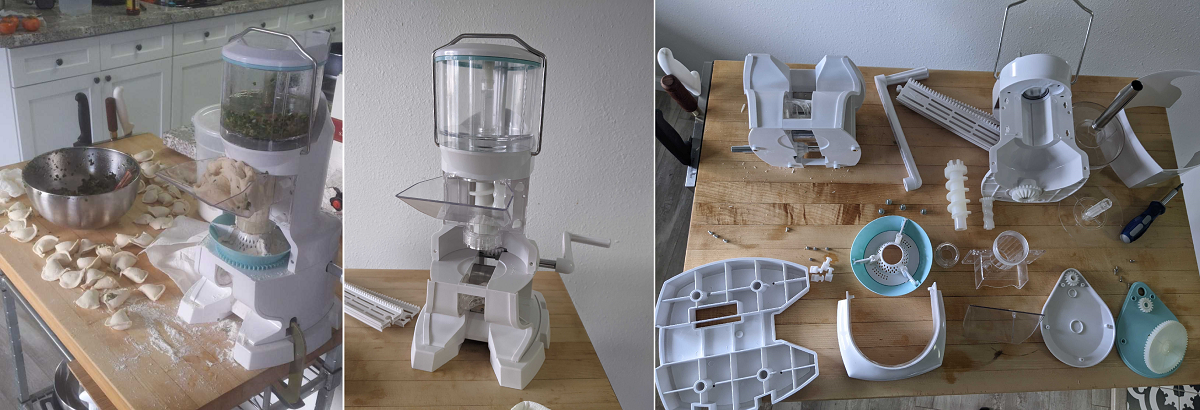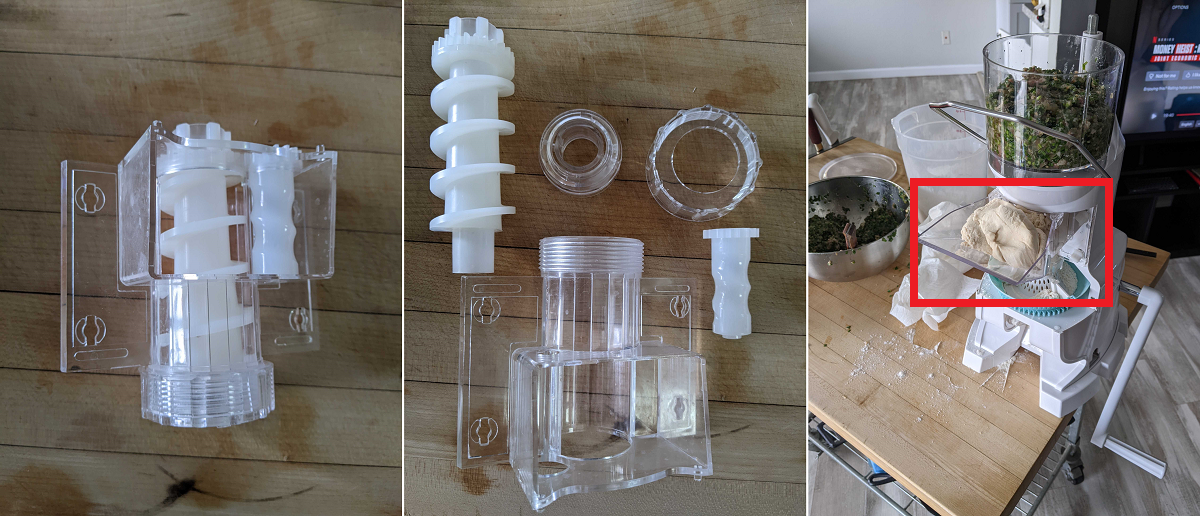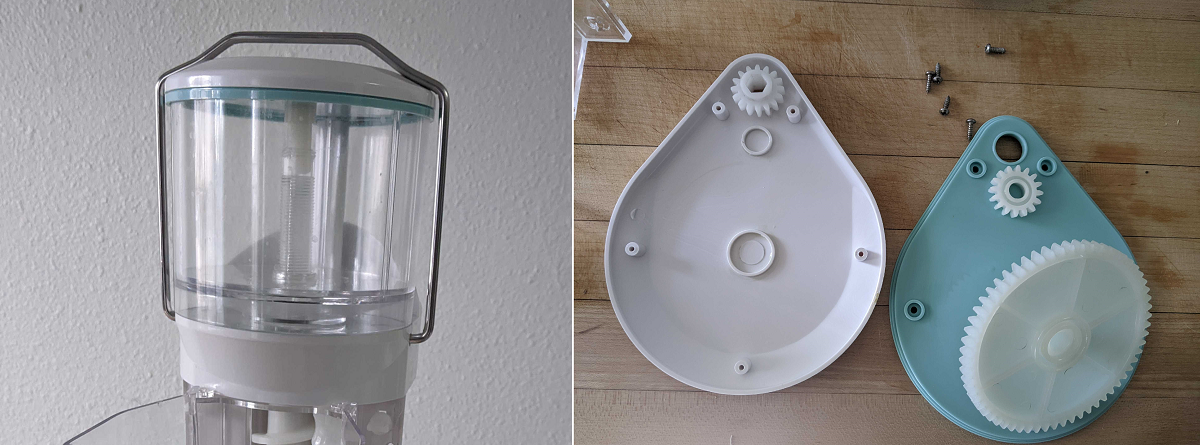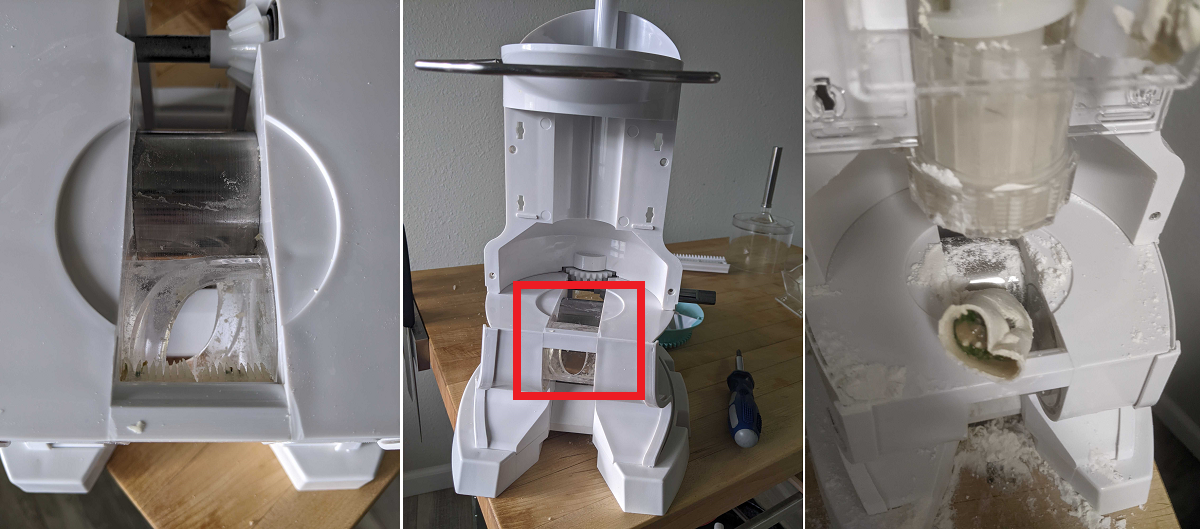Hunger got you down?,
Here's many mini morsels,
Flavor costs extra

I don't remember if I was drunk or just emotionally vulnerable when I bought this dumpling-making machine off Aliexpress in the early Fall, but it finally arrived in the first week of December, and it was quite the early xmas surprise. I'm astounded it did anything, much less produce dumplings that are actually edible, and honestly, not that far off from the frozen packs of industrially mass-produced dumplings you'd snag out of the freezer at 99 Ranch. However, I'm also fairly confident that it won't last too many more uses, not that I'd really want to use this on the regular unless I had a repeated need to pull out a party trick.
Actually, we should ask: who is this product actually for? Someone or group developed (and presumably tested) this, designed it for assembly/production, and seemingly has produced enough to keep it listed on Aliexpress. Surely they can't rely on schmucks like me who like teardowns and foodtech to hit their sales goals. Who is looking for a tabletop, hand-crank mechanism that produces super doughy-dumplings not all that much faster (if at all) than your average Asian? I think you could even argue that an individual dumpling folder would provide better throughput and quality. The only scenario I can think of where this device would provide dividends is if someone who has never made dumplings before was tasked with making a significant batch for someone else who's never had dumplings before or simply has no preference for taste.
(If it's not clear: no, you most definitely shouldn't buy this thing either)
As has been the case with most things I've torn down off of Aliexpress, the product market fit is questionable (if it's existent at all), and the usefulness is negligible at best, but the mechanisms are pretty neat. A single crank couples the motions of a piston pushing the filling through a central conduit, a pair of augers/screws that extrudes a (somewhat thin) tube of dough around the filling, and a rotating "stamp" of sorts that punches out dumpling forms out of the aforementioned filling-dough sausage that's being pooped out of the machine. The crank also rotates a 'flour' duster that is supposed to prevent the dumplings from sticking, as well as a conveyor platform of sorts to avoid needing the user to manually separate the dumplings as they come out, but neither were all that effective and are probably best left out of the machine.

Operationally, I had a great deal of problems ensuring that the dough was adequately filling the auger/screw mechanism. Whereas the filling hopper has an even pressure applied from above, reliably funneling the filling through the central tube, it seems that the operator needs to manually ensure that the there's sufficient dough being extruded to keep pace withe filling's dispense rate. I wonder if a softer, wetter dough than what's typically used for dumpling wrappers would work better, as the screws by themselves do very little to pull in the dough. The dough extrusion mechanism forces the dough through a fairly small annular cross-section around the central filling tube. I'm surprised the plastic screws/augers are able to force dough through such a small opening, and it makes cleaning/maintenance afterwards a total pain. The tip of the dough-extrusion structure is a three-piece assembly with captured insert and screwed retaining cap. Due to the fastening constraints, there's a discontinuity in the dough flow introduced fairly close to the endpoint, which I think makes it more difficult to ensure a consistent extrusion.

For the filling, a plastic plate driven by a plastic screw, coupled to a series of gears connected to the primary crank, presses down on the filling and extrudes it through the central stainless steel tube. I'm not sure if the central tube is metal because that's the preferred low-friction material for dispensing foodstuffs or if injection molding it as part of the upper hopper would've actually been more cost-prohibitive. I also wonder if there was a similar reason for the taper around the central tube being so shallow, as that (intuitively) seems like quite a bit of excessive force being placed on the flimsy central plastic screw once the filling level gets low. To be fair, dumpling filling tends to be both quite loose and slippery, if you respect and embrace the joy that pork fat and sesame oil grants us.

The stamping sub-system acts like a well-oiled (if you oil it) and meticulously-timed sphincter in our dumpling-dumping machine. The rotating stamp has cutouts in it and spins against a curved steel surface, pinching the stream of dough and filling twice per rotation. The dumplings are formed longitudinally, if that makes sense, with the spacing between roller surfaces set precisely to compress the dough into sealed edges. This means you don't get the folds/creases or plump body of a well-made, traditional dumpling, though I wonder if the rotating rate of the drum and the cutout geometry could be adjusted to better give you that effect. Similar to industrial bao-making machines, the end result seems to be mostly at the mercy of the incoming extruded dough/filling sausage.

The overall construction doesn't exactly scream "industrial" or "dependable." More like "adequate" and "not terribly flimsy." Most of the gears, even the ones that would never come in contact with foodstuffs, are plastic, rotating in loosely toleranced holes in the surrounding plastic frame. I think I found two metal bearings in the whole machine, neither of which were sealed or really greased. To be fair, the shipped instructions do warn the user to avoid ever submerging the entire device during cleaning, as that would damage much of the metal components. The extensive use of plastic throughout and the lack of proper bearings (for both support and low rolling friction) didn't inspire too much confidence with regards to the machine's longevity, though maybe there's a loose argument that replacement parts and repairs are easier to come by.
Nah. It's just cheap, and the manufacturer's trying to save a buck (as they should).
Taking a step back, this machine's a nice encapsulation of the tradeoffs and process adjustments we typically would need (or at least prefer) to enable automation of a manually-dexterous task:
- Maintaining a consistent rate or ensuring coupled rates of operation is easier than triggering specific, discrete events. This thing doesn't fill, fold, and dispense individual dumplings; it crimps subsections off two parallel streams of dough and filling being pushed out at the same rate.
- Compromises need to be made in quality due to changes in production methodology. The dumpling wrapper's an extruded consistency, not rolled/flattened/compressed. Wrapper needs to be thicker so that the machine doesn't tear it while extruding. The dumpling body can't be as full and plump as traditionally made for the same reasons. No crimping or folds on the edges
- There's a good amount of prep/preloading/priming needed to get everything flowing in sync. There's always some amount of dough and filling stuck midway in the machine once we've exhausted our ingredients. Once the ingredient packing drops below a certain point, the extrusion/dispensing becomes inconsistent, and without active feedback (which this gizmo certainly lacks), there's no way to compensate.
- The user gets stuck with a set of new tasks that otherwise wouldn't be necessary. In this case, cleaning the machine is a huge hassle. Much of the system needs to be totally disassembled and then soaked to make sure food bits aren't left behind, and we also need to take special care to not get the rest of the machine wet, since the metal bearing components are left mostly exposed.
- Friction will get you one way or another. We either had to oil the dumpling stamping unit or keep the extruded dumpling coated in flower for them to reliably separate and drop out of the machine. Otherwise, we had to manually poke/prod the dumpling as they formed to ensure they'd separate. Either approach requires some degree of monitoring and upkeep, and neither was something I particularly wanted to deal with.
Sudden closing thought: was this like the equivalent of an Easy-bake Oven for 30-something Asian engineers?